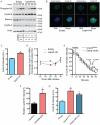Overexpression of ubiquitin specific protease 44 (USP44) induces chromosomal instability and is frequently observed in human T-cell leukemia
- PMID: 21853124
- PMCID: PMC3154946
- DOI: 10.1371/journal.pone.0023389
Overexpression of ubiquitin specific protease 44 (USP44) induces chromosomal instability and is frequently observed in human T-cell leukemia
Abstract
Cdc20-anaphase promoting complex/cyclosome (Cdc20-APC/C) E3 ubiquitin ligase activity is essential for orderly mitotic progression. The deubiqituinase USP44 was identified as a key regulator of APC/C and has been proposed to suppress Cdc20-APC/C activity by maintaining its association with the inhibitory protein Mad2 until all chromosomes are properly attached to the mitotic spindle. However, this notion has been challenged by data in which a lysine-less mutant of Cdc20 leads to premature anaphase, suggesting that it's ubiquitination is not required for APC/C activation. To further evaluate its role in checkpoint function and chromosome instability, we studied the consequences of over-expression of mouse Usp44 in non-transformed murine embryonic fibroblasts. Here we show that cells with high Usp44 are prone to chromosome segregation errors and aneuploidization. We find that high Usp44 promotes association of Mad2 with Cdc20 and reinforces the mitotic checkpoint. Surprisingly, the APC/C-Cdc20 substrate cyclin B1 is stabilized in G2 when Usp44 is over-expressed, but is degraded with normal kinetics once cells enter mitosis. Furthermore, we show that USP44 expression is elevated in subset of T-cell leukemias. These data are consistent with an important role for USP44 in regulating Cdc20-APC/C activity and suggest that high levels of this enzyme may contribute to the pathogenesis of T-ALL.
Conflict of interest statement
Figures






Similar articles
-
Anaphase initiation is regulated by antagonistic ubiquitination and deubiquitination activities.Nature. 2007 Apr 19;446(7138):876-81. doi: 10.1038/nature05694. Nature. 2007. PMID: 17443180
-
USP44 regulates centrosome positioning to prevent aneuploidy and suppress tumorigenesis.J Clin Invest. 2012 Dec;122(12):4362-74. doi: 10.1172/JCI63084. Epub 2012 Nov 26. J Clin Invest. 2012. PMID: 23187126 Free PMC article.
-
Inhibitory factors associated with anaphase-promoting complex/cylosome in mitotic checkpoint.Proc Natl Acad Sci U S A. 2007 Mar 20;104(12):4870-5. doi: 10.1073/pnas.0700523104. Epub 2007 Mar 13. Proc Natl Acad Sci U S A. 2007. PMID: 17360335 Free PMC article.
-
Impressionist portraits of mitotic exit: APC/C, K11-linked ubiquitin chains and Cezanne.Cell Cycle. 2019 Mar-Apr;18(6-7):652-660. doi: 10.1080/15384101.2019.1593646. Epub 2019 Mar 28. Cell Cycle. 2019. PMID: 30874463 Free PMC article. Review.
-
Cdc20: At the Crossroads between Chromosome Segregation and Mitotic Exit.Trends Biochem Sci. 2017 Mar;42(3):193-205. doi: 10.1016/j.tibs.2016.12.001. Epub 2017 Feb 12. Trends Biochem Sci. 2017. PMID: 28202332 Review.
Cited by
-
Ubiquitin-dependent regulation of Foxp3 and Treg function.Immunol Rev. 2015 Jul;266(1):27-45. doi: 10.1111/imr.12312. Immunol Rev. 2015. PMID: 26085205 Free PMC article. Review.
-
Regulatory network analysis reveals the oncogenesis roles of feed-forward loops and therapeutic target in T-cell acute lymphoblastic leukemia.BMC Med Genomics. 2019 Jan 15;12(1):8. doi: 10.1186/s12920-018-0469-0. BMC Med Genomics. 2019. PMID: 30646895 Free PMC article.
-
Emerging regulatory mechanisms in ubiquitin-dependent cell cycle control.J Cell Sci. 2012 Jan 15;125(Pt 2):255-63. doi: 10.1242/jcs.091199. J Cell Sci. 2012. PMID: 22357967 Free PMC article. Review.
-
Insight into the physiological and pathological roles of USP44, a potential tumor target (Review).Oncol Lett. 2022 Nov 1;24(6):455. doi: 10.3892/ol.2022.13575. eCollection 2022 Dec. Oncol Lett. 2022. PMID: 36380875 Free PMC article. Review.
-
The mitotic checkpoint complex (MCC): looking back and forth after 15 years.AIMS Mol Sci. 2016;3(4):597-634. doi: 10.3934/molsci.2016.4.597. Epub 2016 Oct 24. AIMS Mol Sci. 2016. PMID: 28920074 Free PMC article.
References
Publication types
MeSH terms
Substances
Grants and funding
LinkOut - more resources
Full Text Sources
Molecular Biology Databases
Research Materials

